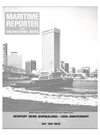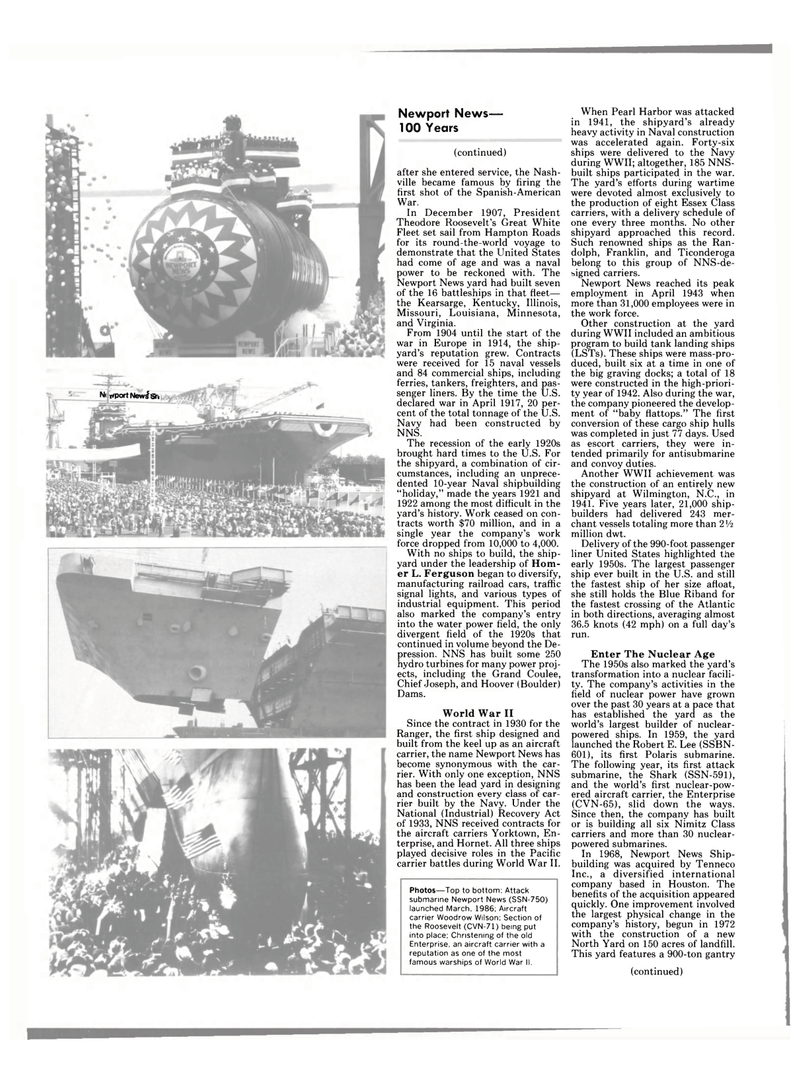
Page 28: of Maritime Reporter Magazine (May 1986)
Read this page in Pdf, Flash or Html5 edition of May 1986 Maritime Reporter Magazine
Photos—Top to bottom: Attack submarine Newport News (SSN-750) launched March. 1986; Aircraft carrier Woodrow Wilson; Section of the Roosevelt (CVN-71) being put into place; Christening of the old
Enterprise, an aircraft carrier with a reputation as one of the most famous warships of World War II.
When Pearl Harbor was attacked in 1941, the shipyard's already heavy activity in Naval construction was accelerated again. Forty-six ships were delivered to the Navy during WWII; altogether, 185 NNS- built ships participated in the war.
The yard's efforts during wartime were devoted almost exclusively to the production of eight Essex Class carriers, with a delivery schedule of one every three months. No other shipyard approached this record.
Such renowned ships as the Ran- dolph, Franklin, and Ticonderoga belong to this group of NNS-de- ^igned carriers.
Newport News reached its peak employment in April 1943 when more than 31,000 employees were in the work force.
Other construction at the yard during WWII included an ambitious program to build tank landing ships (LSTs). These ships were mass-pro- duced, built six at a time in one of the big graving docks; a total of 18 were constructed in the high-priori- ty year of 1942. Also during the war, the company pioneered the develop- ment of "baby flattops." The first conversion of these cargo ship hulls was completed in just 77 days. Used as escort carriers, they were in- tended primarily for antisubmarine and convoy duties.
Another WWII achievement was the construction of an entirely new shipyard at Wilmington, N.C., in 1941. Five years later, 21,000 ship- builders had delivered 243 mer- chant vessels totaling more than 2 V2 million dwt.
Delivery of the 990-foot passenger liner United States highlighted the early 1950s. The largest passenger ship ever built in the U.S. and still the fastest ship of her size afloat, she still holds the Blue Riband for the fastest crossing of the Atlantic in both directions, averaging almost 36.5 knots (42 mph) on a full day's run.
Enter The Nuclear Age
The 1950s also marked the yard's transformation into a nuclear facili- ty. The company's activities in the field of nuclear power have grown over the past 30 years at a pace that has established the yard as the world's largest builder of nuclear- powered ships. In 1959, the yard launched the Robert E. Lee (SSBN- 601), its first Polaris submarine.
The following year, its first attack submarine, the Shark (SSN-591), and the world's first nuclear-pow- ered aircraft carrier, the Enterprise (CVN-65), slid down the ways.
Since then, the company has built or is building all six Nimitz Class carriers and more than 30 nuclear- powered submarines.
In 1968, Newport News Ship- building was acquired by Tenneco
Inc., a diversified international company based in Houston. The benefits of the acquisition appeared quickly. One improvement involved the largest physical change in the company's history, begun in 1972 with the construction of a new
North Yard on 150 acres of landfill.
This yard features a 900-ton gantry (continued) (continued) after she entered service, the Nash- ville became famous by firing the first shot of the Spanish-American
War.
In December 1907, President
Theodore Roosevelt's Creat White
Fleet set sail from Hampton Roads for its round-the-world voyage to demonstrate that the United States had come of age and was a naval power to be reckoned with. The
Newport News yard had built seven of the 16 battleships in that fleet— the Kearsarge, Kentucky, Illinois,
Missouri, Louisiana, Minnesota, and Virginia.
From 1904 until the start of the war in Europe in 1914, the ship- yard's reputation grew. Contracts were received for 15 naval vessels and 84 commercial ships, including ferries, tankers, freighters, and pas- senger liners. By the time the U.S. declared war in April 1917, 20 per- cent of the total tonnage of the U.S.
Navy had been constructed by
NNS.
The recession of the early 1920s brought hard times to the U.S. For the shipyard, a combination of cir- cumstances, including an unprece- dented 10-year Naval shipbuilding "holiday," made the years 1921 and 1922 among the most difficult in the yard's history. Work ceased on con- tracts worth $70 million, and in a single year the company's work force dropped from 10,000 to 4,000.
With no ships to build, the ship- yard under the leadership of Hom- er L. Ferguson began to diversify, manufacturing railroad cars, traffic signal lights, and various types of industrial equipment. This period also marked the company's entry into the water power field, the only divergent field of the 1920s that continued in volume beyond the De- pression. NNS has built some 250 hydro turbines for many power proj- ects, including the Grand Coulee,
Chief Joseph, and Hoover (Boulder)
Dams.
World War II
Since the contract in 1930 for the
Ranger, the first ship designed and built from the keel up as an aircraft carrier, the name Newport News has become synonymous with the car- rier. With only one exception, NNS has been the lead yard in designing and construction every class of car- rier built by the Navy. Under the
National (Industrial) Recovery Act of 1933, NNS received contracts for the aircraft carriers Yorktown, En- terprise, and Hornet. All three ships played decisive roles in the Pacific carrier battles during World War II.
Newport News— 100 Years
N< report Newi Sr.

 27
27

 29
29
